Realize the dynamic counting of the digital tube, once every 0.1 seconds
The connection modes of digital tubes are divided into common cathode digital tube and common anode digital tube.
Digital Pipe Pin: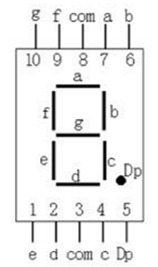
The two com pins in the figure above are actually linked together. The public end of the other pins is called bit selection. The level of bit selection determines whether the digital tube can be lighted or not. The other pins select signals for segments and decide which diode on the digital tube emits light.
Common cathode digital tube connection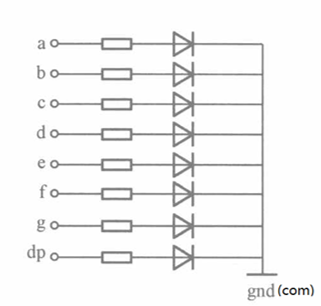
Connection mode of common anode digital tube: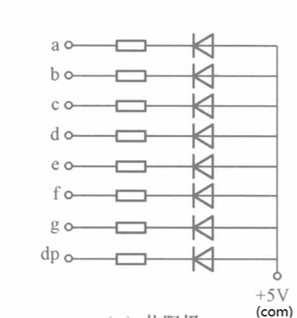
Gongyang Eight-segment Pole Digital Tube True Value Table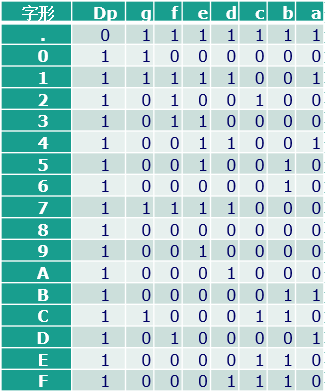
Digital tube schematic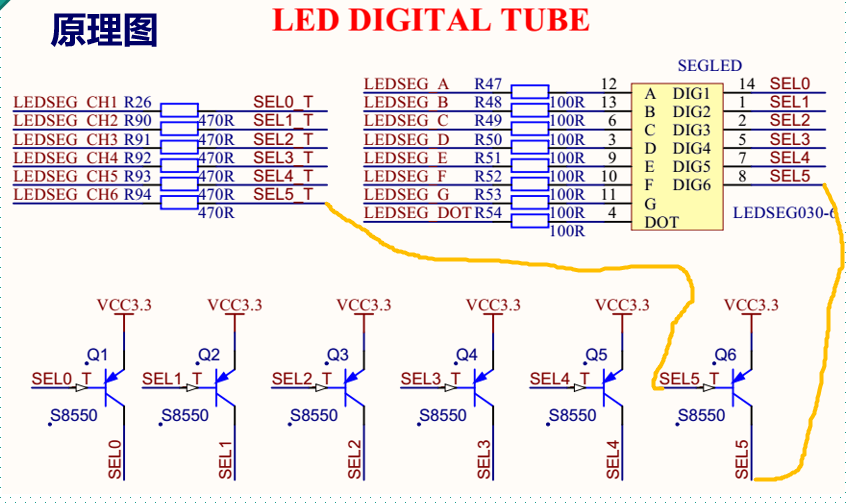
Take the fifth digital tube as an example, LED SEG CH6 is connected to the base of Q6 triode through 470R resistance, bitwise SEL5 of the fifth digital tube is connected to the collector of Q6 triode, emitter of Q6 triode, and power supply.So in the code, simply assign the LED SEG CH6 (code sense bit selection) to 0 (low level), then the real segment of the tube connects to the power supply, this digital tube bit co-anode digital tube.In the circuit diagram of the digital tube, six digital tubes share eight segment selector signals, which are connected with the LED pin.So, when the display is static, the six digital tubes display the same.
Digital tube dynamic display drive mode: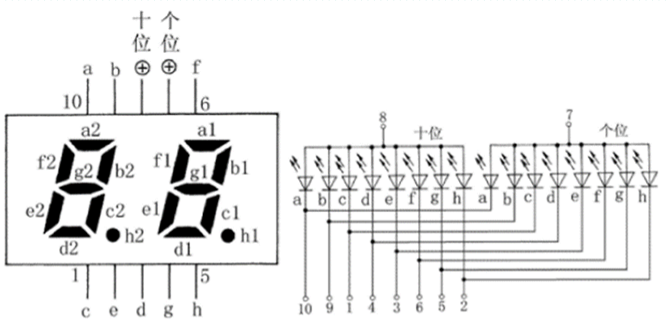
At the same time, only one digital tube can be displayed. According to the persistence effect of human vision, the time interval of the alternating display of the digital tube can be controlled. The switch time of the digital tube is fast enough, and the naked eye effect is that multiple digital tubes are illuminated at the same time.
System Diagram
Top module schematic
point[5:0] and sign were not used in this experiment.
Code implementation:
Top Module Design
module top_seg_led( input sys_clk,//Global clock signal input sys_rst_n, //Reset signal output [5:0] seg_sel, //Digital Pipe Position Selection Signal output [7:0] seg_led //Digital tube segment selection signal ); wire define wire [19:0] data; //Numeric value displayed by digital tube wire [5:0] point; //Position of decimal point on digital tube wire en; //Digital tube display enable signal wire sign; //Symbol bits for display data on digital tubes //Counter module that generates the data the tube needs to display count u_count( .clk (sys_clk), //clock signal .rst_n (sys_rst_n), //Reset signal .data (data), //Number to display for 6-digit tube .point (point), ); //Digital tube dynamic display module seg_led u_seg_led( .clk (sys_clk), //clock signal .rst_n (sys_rst_n), //Reset signal .data (data), //Displayed values .point (point), //Decimal specific display position, high level effective .en (en), //Digital tube enabling signal .sign (sign), //Symbol Bit, High Level Display Negative Sign .seg_sel (seg_sel), //Bit Selection .sed_led (seg_led) //Segment Selection ); endmodule
Timing module
module count( input clk, //clock signal input rst_n, //Reset signal output reg [19:0] data, //Six digital tubes display values, six digital tubes display 999999 max, occupy 20bit output reg [5:0] point, //The position of decimal point, high level lighting corresponds to decimal point on the digital tube position. (Not used in this experiment) output reg en, //Digital tube enabling signal output reg sign //Symbol bit, negative sign at high level, no negative sign at low level, not used in this experiment ); //parameter define parameter MAX_NUM = 23'd5000_000; //Maximum counter count, the tube counts every 0.01s //reg define reg [22:0] cnt; //Counter for timing 100ms(0.1s) reg flag; //Sign signal //When the counter counts the system clock up to 10ms, it outputs a pulse signal of one clock cycle always @ (posedge clk or negedge rst_n) begin if(!rst_n) begin cnt <= 23'b0; flag <= 1'b0; end else if (cnt < MAX_NUM - 1'b1) begin cnt <= cnt + 1'b1; flag <= 1'b0; end else begin cnt <= 23'b0; flag <= 1'b1; //Output a cycle high level signal every 0.01 seconds end end //The data that the tube needs to display, from 0 to 999999 always @ (posedge clk or negedge rst_n) begin if(!rst_n) begin data <= 20'b0; point <= 6'b000000; //No decimal points need to be displayed, assign 0 en <= 1'b0; sign <= 1'b0; //Negative sign not required, assign 0 end else begin point <= 6'b000000; //Do not display decimal points en <= 1'b1; //Turn on the digital tube enable signal sign <= 1'b0; //Do not show negative sign if (flag) begin //Display values accumulating every 0.01s if(data < 20'd999999) data <= data + 1'b1; else data <= 20'b0; end end end endmodule
Digital tube design module
module seg_led( input clk , // clock signal input rst_n , // Reset signal input [19:0] data , // Number to display for 6-digit tube input [5:0] point , // Decimal point specific display position, from high to low, high level effective input en , // Digital tube enabling signal input sign , // Symbol bits (high level display "-") output reg [5:0] seg_sel, // Select the position of the digital tube, the leftmost digital tube is the highest position output reg [7:0] seg_led // Digital tube segment selection ); //parameter define localparam CLK_DIVIDE = 4'd10 ; // Clock frequency dividing factor//10 dividing frequency to system clock, system clock 50Mhz, after 10 dividing frequency to 5Mhz localparam MAX_NUM = 13'd5000 ; // Count value required to count 1ms of the tube-driven clock (5MHz)//Time interval for tube switching //reg define reg [ 3:0] clk_cnt ; // Clock crossover counter reg dri_clk ; // Digital tube drive clock, 5MHz reg [23:0] num ; // 24-bit bcd code register reg [12:0] cnt0 ; // Digital tube driven clock counter reg flag ; // Flag signal (marking cnt0 count up to 1ms) reg [2:0] cnt_sel ; // Digital Pipe Position Selection Counter reg [3:0] num_disp ; // Data displayed by the current digital tube reg dot_disp ; // Decimal Point on Current Digital Tube Display //wire define wire [3:0] data0 ; // 100,000 digits wire [3:0] data1 ; // Ten thousand digits wire [3:0] data2 ; // thousands wire [3:0] data3 ; // hundreds digit wire [3:0] data4 ; // Ten digits wire [3:0] data5 ; // Number of digits //***************************************************** //** main code //***************************************************** //Extracts the bits of the decimal number corresponding to the displayed value assign data0 = data % 4'd10; // Number of digits assign data1 = data / 4'd10 % 4'd10 ; // Ten digits assign data2 = data / 7'd100 % 4'd10 ; // hundreds digit assign data3 = data / 10'd1000 % 4'd10 ; // thousands assign data4 = data / 14'd10000 % 4'd10; // Ten thousand digits assign data5 = data / 17'd100000; // 100,000 digits //The reason for crossover, when extracting decimal bits, if the frequency of the original clock is used, //These assign statements cannot be completed within a clock cycle //Digital tube driven clock dri_clk with 5 MHz obtained when the system clock is divided into 10 frequencies always @(posedge clk or negedge rst_n) begin if(!rst_n) begin clk_cnt <= 4'd0; dri_clk <= 1'b1; end else if(clk_cnt == CLK_DIVIDE/2 - 1'd1) begin clk_cnt <= 4'd0; dri_clk <= ~dri_clk; end else begin clk_cnt <= clk_cnt + 1'b1; dri_clk <= dri_clk; end end //Converts a 20-bit binary number to 8421bcd code (that is, a 4-bit binary number represents a 1-bit decimal number) always @ (posedge dri_clk or negedge rst_n) begin if (!rst_n) num <= 24'b0; else begin //Judgement Sixth if (data5 || point[5]) begin //If the display data is a 6-bit decimal number, //If the highest bit has a numeric display, then the rest of the positions have a numeric display num[23:20] <= data5; //Then assign values to 6-digit tube in turn num[19:16] <= data4; num[15:12] <= data3; num[11:8] <= data2; num[ 7:4] <= data1; num[ 3:0] <= data0; end else begin //Judge Fifth if (data4 || point[4]) begin //Assign values to the lower 5-digit tube if the display data is a 5-digit decimal number num[19:0] <= {data4,data3,data2,data1,data0}; if(sign) //Determine if the highest bit has a negative sign num[23:20] <= 4'd11; //If a negative sign is required, the highest bit (6th bit) is the sign bit else num[23:20] <= 4'd10; //When a negative sign is not required, no characters are displayed at the sixth position end else begin //Assign values to the lower 4-digit tube if the display data is a 4-digit decimal number if (data3 || point[3]) begin num[15: 0] <= {data3,data2,data1,data0}; num[23:20] <= 4'd10; //The 6th digit does not display any characters if(sign) //If a negative sign is required, the highest (fifth) position is the sign bit num[19:16] <= 4'd11; else //When a negative sign is not required, no characters are displayed in the fifth position num[19:16] <= 4'd10; end else begin //Assign values to low 3-digit tube if display data is 3-digit decimal if (data2 || point[2]) begin num[11: 0] <= {data2,data1,data0}; //Bits 6 and 5 do not display any characters num[23:16] <= {2{4'd10}}; if(sign) //If a negative sign is required, the highest bit (the fourth bit) is the symbol bit num[15:12] <= 4'd11; else //When a negative sign is not required, no character is displayed at the fourth position num[15:12] <= 4'd10; end else begin //Assign a low 2-digit tube if the display data is a 2-digit decimal number if (data1 || point[1]) begin num[ 7: 0] <= {data1,data0}; //Bits 6, 5, 4 do not display any characters num[23:12] <= {3{4'd10}}; if(sign) //If a negative sign is required, the highest bit (third bit) is the sign bit num[11:8] <= 4'd11; else //The third digit does not display any characters when a negative sign is not required num[11:8] <= 4'd10; end else begin //Assign a value to the lowest digit tube if the display data is a decimal digit num[3:0] <= data0; //Bits 6 and 5 do not display any characters num[23:8] <= {4{4'd10}}; if(sign) //If a negative sign is required, the highest (second) position is the sign bit num[7:4] <= 4'd11; else //The second digit does not display any characters when a negative sign is not required num[7:4] <= 4'd10; end end end end end end end //Pulse signal of one clock cycle is output whenever the counter counts the clock of the digital tube drive up to 1ms always @ (posedge dri_clk or negedge rst_n) begin if (rst_n == 1'b0) begin cnt0 <= 13'b0; flag <= 1'b0; end else if (cnt0 < MAX_NUM - 1'b1) begin cnt0 <= cnt0 + 1'b1; flag <= 1'b0; end else begin cnt0 <= 13'b0; flag <= 1'b1; end end //Cnt_selCount from 0 to 5 to select the tube that is currently on display always @ (posedge dri_clk or negedge rst_n) begin if (rst_n == 1'b0) cnt_sel <= 3'b0; else if(flag) begin if(cnt_sel < 3'd5) //Six-digit digital tube display in turn cnt_sel <= cnt_sel + 1'b1; else cnt_sel <= 3'b0; end else cnt_sel <= cnt_sel; end //Control the digital tube position selection signal to make the 6-digit tube display in turn always @ (posedge dri_clk or negedge rst_n) begin if(!rst_n) begin seg_sel <= 6'b111111; //Bit Selection Signal Low Level Effective num_disp <= 4'b0; dot_disp <= 1'b1; //Common anode digital tube, low level conduction end else begin if(en) begin case (cnt_sel) 3'd0 :begin seg_sel <= 6'b111110; //Show the lowest digit tube position num_disp <= num[3:0] ; //Displayed data dot_disp <= ~point[0]; //The decimal point displayed//Because the LED is illuminated by the low level of the digital tube, if the corresponding point[] for the decimal point is displayed as 1, the inverse is 0 and assigned to the LED end 3'd1 :begin seg_sel <= 6'b111101; //Display number 1 tube num_disp <= num[7:4] ; dot_disp <= ~point[1]; end 3'd2 :begin seg_sel <= 6'b111011; //Display number 2 tube num_disp <= num[11:8]; dot_disp <= ~point[2]; end 3'd3 :begin seg_sel <= 6'b110111; //Display number 3 tube num_disp <= num[15:12]; dot_disp <= ~point[3]; end 3'd4 :begin seg_sel <= 6'b101111; //Show number 4 tube num_disp <= num[19:16]; dot_disp <= ~point[4]; end 3'd5 :begin seg_sel <= 6'b011111; //Display the top position of the digital tube num_disp <= num[23:20]; dot_disp <= ~point[5]; end default :begin seg_sel <= 6'b111111; num_disp <= 4'b0; dot_disp <= 1'b1; end endcase end else begin seg_sel <= 6'b111111; //When the enable signal is 0, all the digital tubes are not displayed num_disp <= 4'b0; dot_disp <= 1'b1; end end end //Control the segment selection signal of the digital tube and display the characters always @ (posedge dri_clk or negedge rst_n) begin if (!rst_n) seg_led <= 8'hc0; else begin case (num_disp) 4'd0 : seg_led <= {dot_disp,7'b1000000}; //Display Number 0 4'd1 : seg_led <= {dot_disp,7'b1111001}; //Display Number 1 4'd2 : seg_led <= {dot_disp,7'b0100100}; //Display Number 2 4'd3 : seg_led <= {dot_disp,7'b0110000}; //Display Number 3 4'd4 : seg_led <= {dot_disp,7'b0011001}; //Display number 4 4'd5 : seg_led <= {dot_disp,7'b0010010}; //Display number 5 4'd6 : seg_led <= {dot_disp,7'b0000010}; //Display number 6 4'd7 : seg_led <= {dot_disp,7'b1111000}; //Display number 7 4'd8 : seg_led <= {dot_disp,7'b0000000}; //Display number 8 4'd9 : seg_led <= {dot_disp,7'b0010000}; //Display number 9 4'd10: seg_led <= 8'b11111111; //Do not display any characters 4'd11: seg_led <= 8'b10111111; //Show negative sign (-) default: seg_led <= {dot_disp,7'b1000000}; endcase end end endmodule

